What Is GPTZero? How to Use It to Detect AI-Generated Text
Since its launch, OpenAI's ChatGPT has become a concern for educational institutions worldwide as students have started to use it to write essays and cheat on assessments. Given how natural the text generated by the chatbot looks, instructors are having a harder time determining whether students' work is original.
To assist teachers in evaluating students' assignments, a computer science graduate developed GPTZero, an AI-checking tool that determines whether a text has been artificially generated.
That all sounds very well and good, but can GPTZero detect AI-created content, and how accurate is it?
What Is GPTZero, and How Does It Work?
GPTZero is an AI text analyzer tool developed by Edward Tian, a computer science graduate, to help instructors distinguish plagiarized text from original work. The tool checks perplexity and burstiness in a text to determine whether it is artificially generated or crafted by a human.
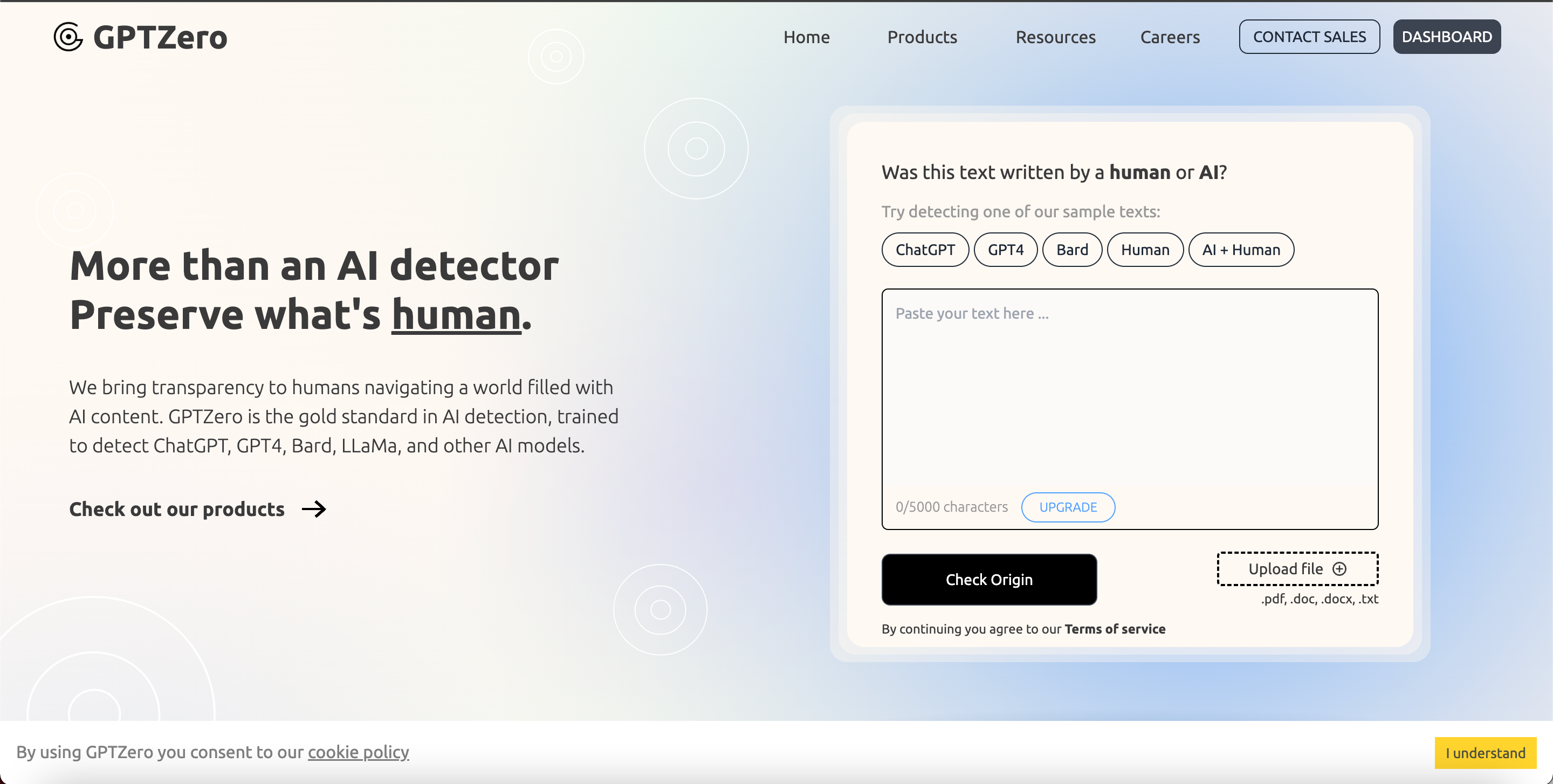
Without going into details, let's look at what these terms mean:
Perplexity measures text randomness in Natural Language Processing (NLP). Text written by a human tends to be less structured and more unpredictable, so its perplexity value should be higher. In contrast, AI-generated text should have a low perplexity score. Burstiness considers other variables not accounted for in perplexity to improve text analysis. The term refers to the appearance of non-common items in random clusters. Text generated by AI tends to have a more consistent structure than text written by humans. Burstiness helps us identify that.GPTZero Classic has been publicly accessible since the beginning of 2023 and is free to use. However, the free version has a character limit of 5,000 per document, and you can only batch-analyze three documents at a time.
GPTZero offers three premium versions to satisfy the needs of users who want to analyze millions of words monthly: Essential (priced at $10 per month), Premium (priced at $16 per month), and Professional (priced at $23 per month). The character limit per document is higher in premium versions than in the free one, and they let you perform more scans per hour, among other perks.
Follow these steps to subscribe to these premium versions:
Navigate to GPTZero's website. Click the Dashboard tab in the top-right corner of the page. Log in with your existing account or create a new account. After logging in, you can compare the available plans and upgrade to one that best suits your needs.
Alternatively, when you're on GPTZero's homepage, click the Upgrade button at the bottom of the text box to view, compare, and purchase a paid plan.

How to Use GPTZero to Detect AI-Generated Text
Unlike ChatGPT, no registration is required on GPTZero. You can access the tool through the website.
Go to GPTZero. Copy and paste the text you want to analyze into the box or upload a file. Click the Check Origin box.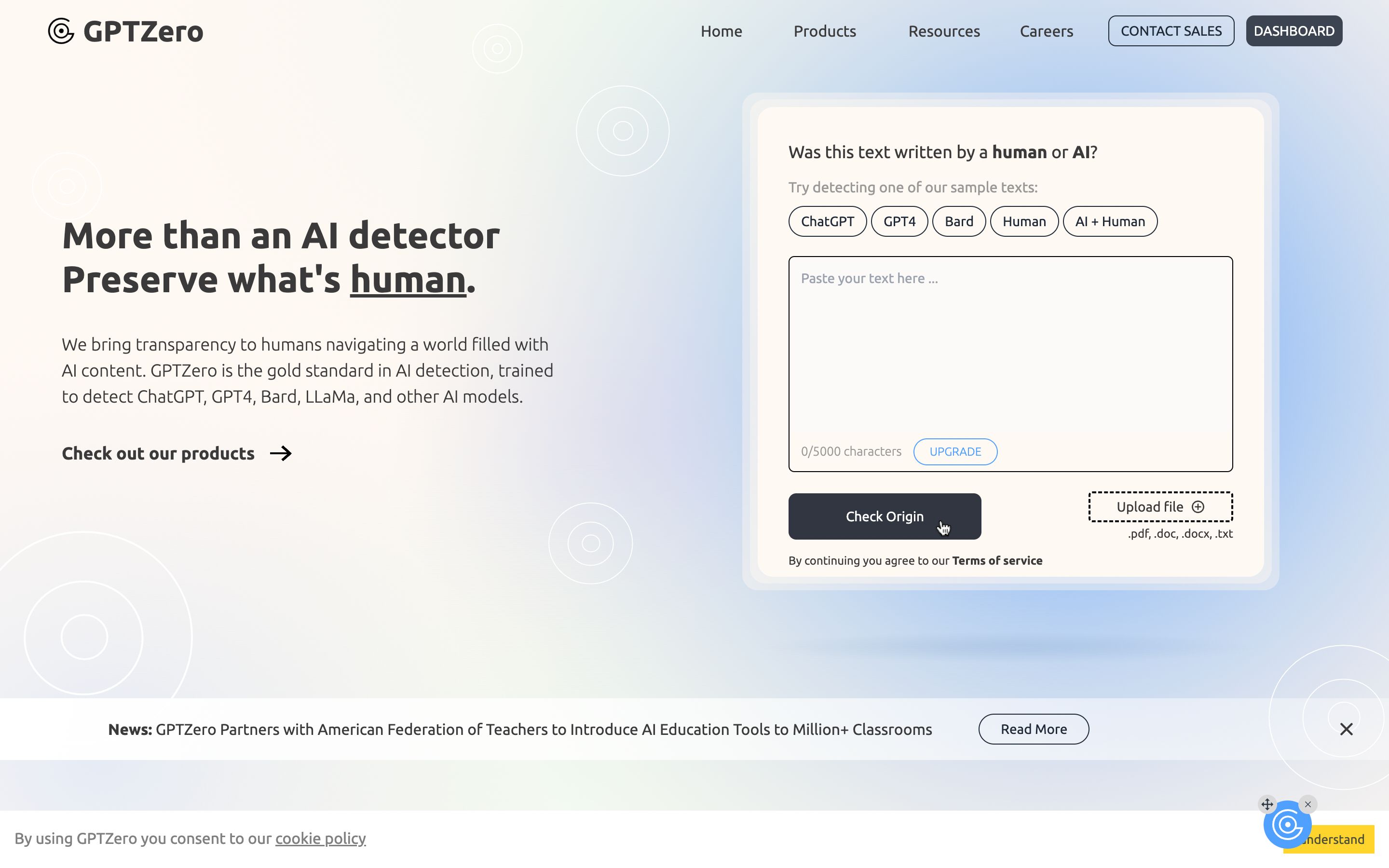
Upon completion of the scan, GPTZero will tell you whether the text was written by a human or generated by artificial intelligence.
How to Use GPTZero's Origin Extension to Detect AI-Generated Text
By downloading GPTZero's free Origin extension on your Chrome browser, you can scan entire web pages and Google Docs for AI-generated text. This new feature simplifies the process of verifying information online.
Navigate to Origin's extension page on the Chrome Web Store. Click Add to Chrome to download the extension. Next, confirm the installation to proceed. Once the extension is installed, you can sign in using your Google account or create a new account. To scan a webpage or a Google doc, click the Origin button on the screen and select Scan Full Page.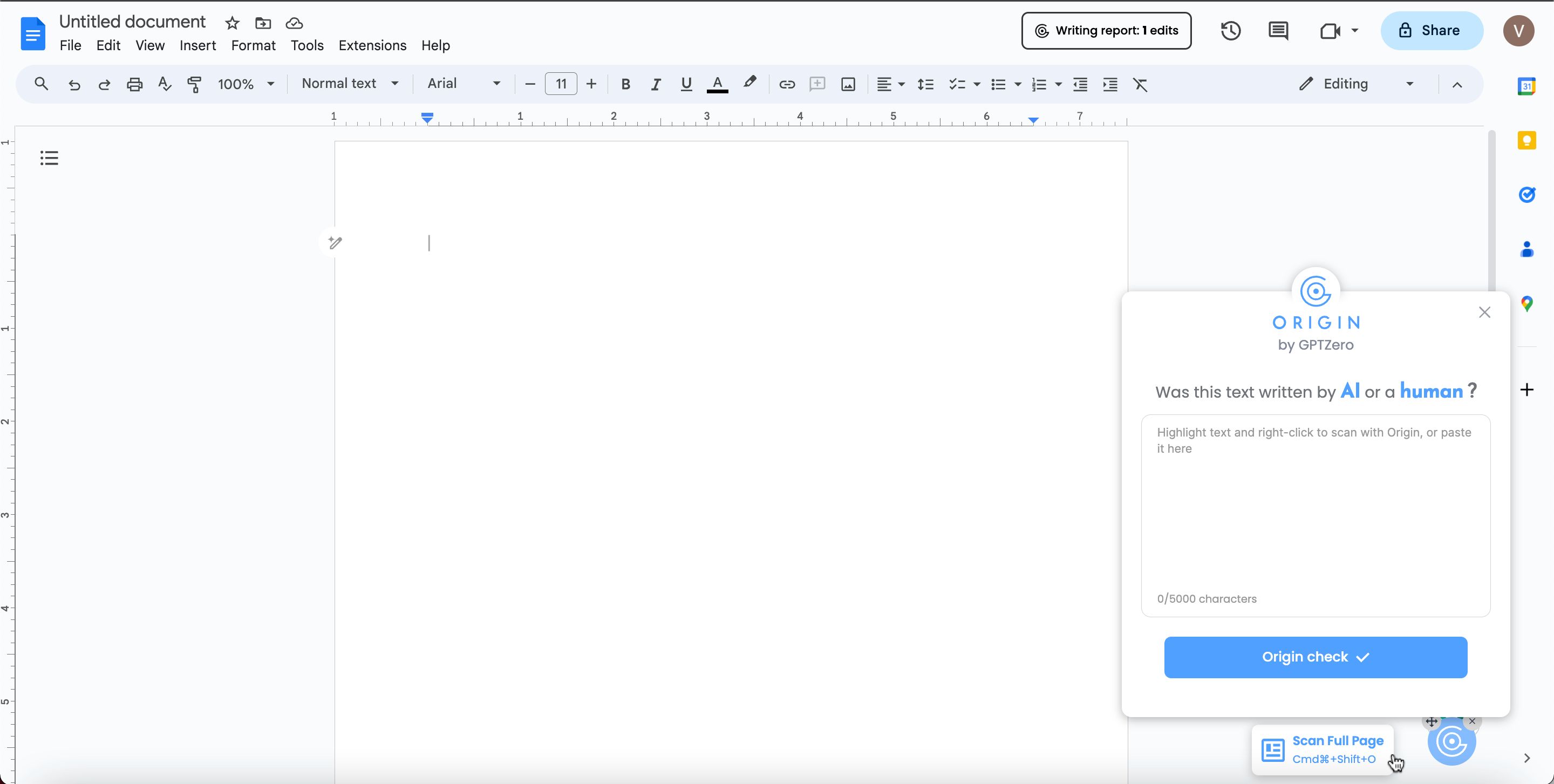
You'll now be able to view the results and determine if the content was written by a person or generated by AI.
Using GPTZero to Analyze Your Writing
A feature that sets GPTZero apart from several other AI-detection tools is that it can analyze your writing patterns. The platform offers a Scan History, which you can use to review any piece of text you scanned using the tool.
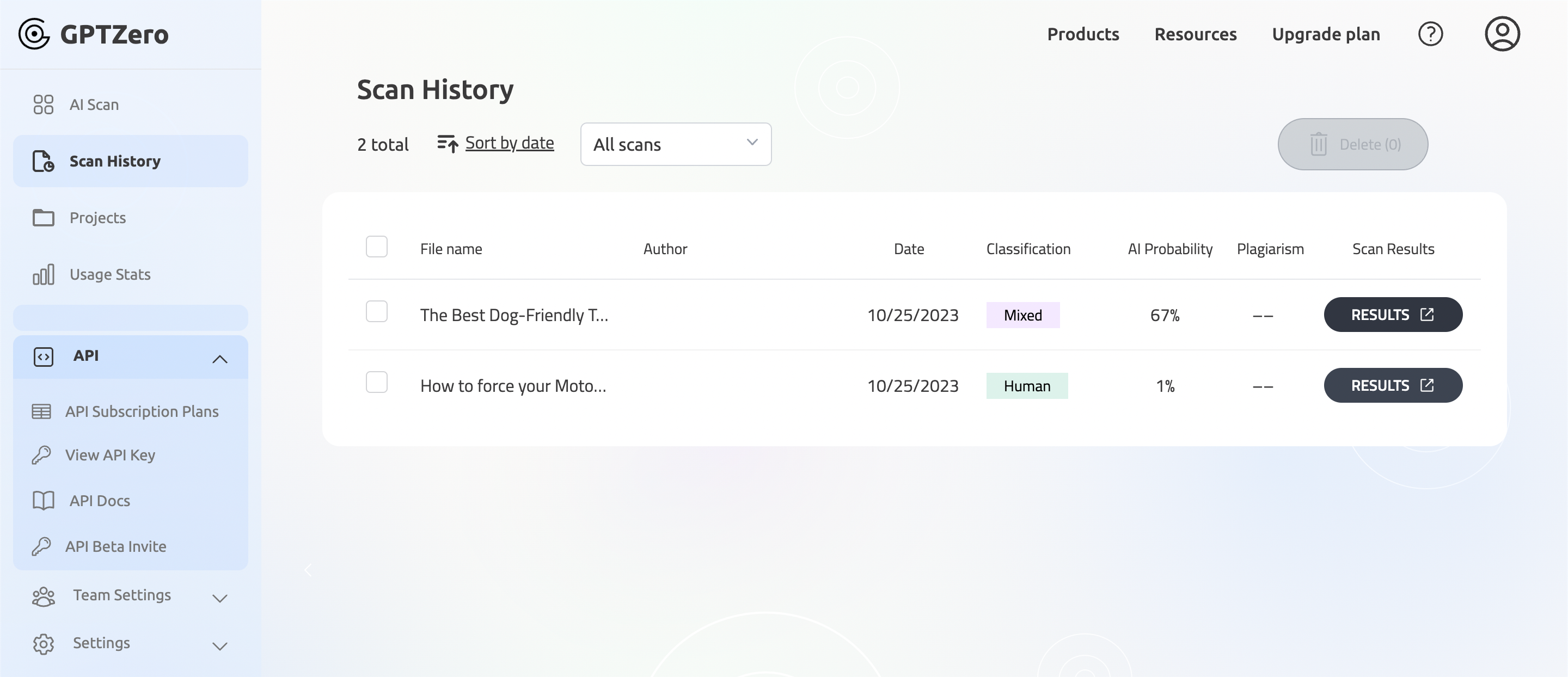
What's more, clicking a specific search result pulls up more detailed data regarding your writing. You'll essentially be able to view why your writing was considered human- or AI-generated.
So, for instance, if GPTZero flagged something you wrote as AI-generated, accessing the Writing Analysis will tell you the reasons for this, like that the content had low perplexity and high burstiness. You can correct these issues to improve the quality, readability, and authenticity of your content.

Can GPTZero Recognize AI-Generated Text Correctly?
To test how accurately GPTZero detects AI-generated text, we'll analyze three texts in the tool: text generated by AI, human-written text, and AI-generated text that has been paraphrased by another tool. Let's see how GPTZero responds to each input.
1. The Analysis of AI-Generated Text in GPTZero
To analyze AI-generated text, let's first generate the text using ChatGPT, an AI chatbot powered by GPT technology. To do that, follow these steps:
Go to OpenAI. Click on the Try ChatGPT button. Log in or sign up to create an account. Enter any prompt to generate a piece of text. Copy the text generated by the tool once it is finished. Analyze the text in GPTZero, as we explained earlier.When we performed this test, GPTZero responded with mixed results to a range of AI-written texts. At times, it couldn't tell in any way that the text was AI-generated, while at others, it correctly surmised that most of the text was AI.
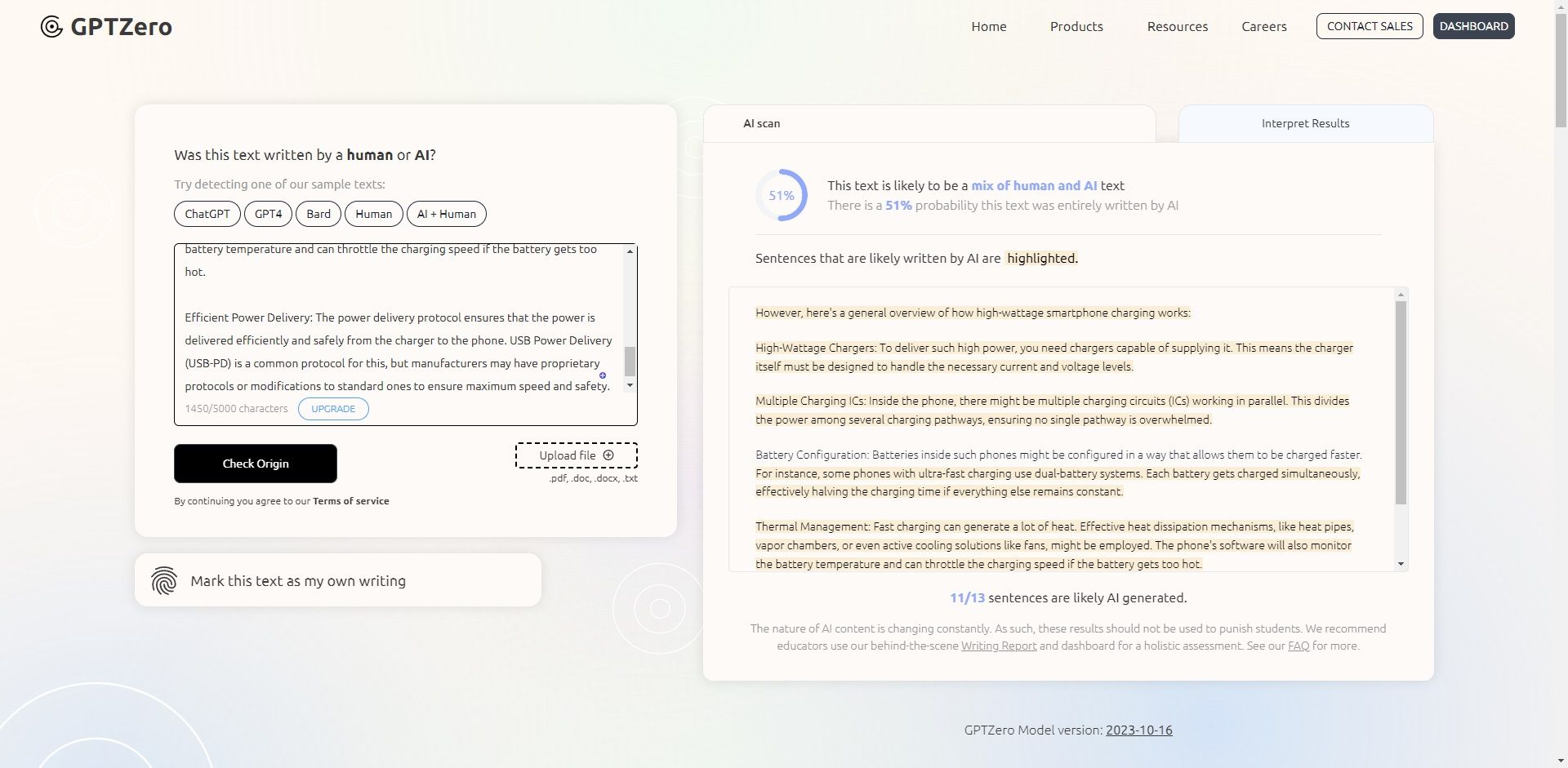
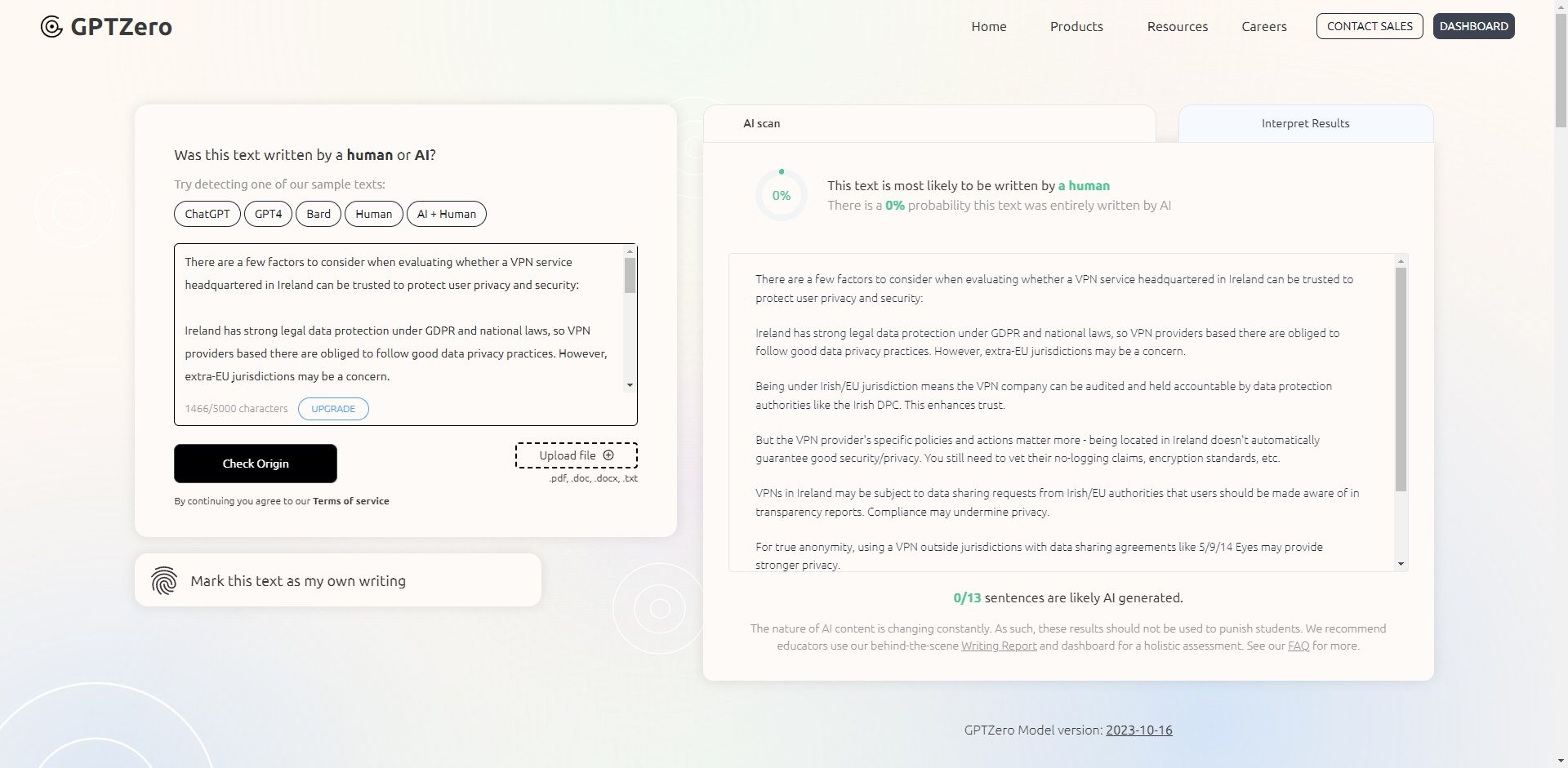
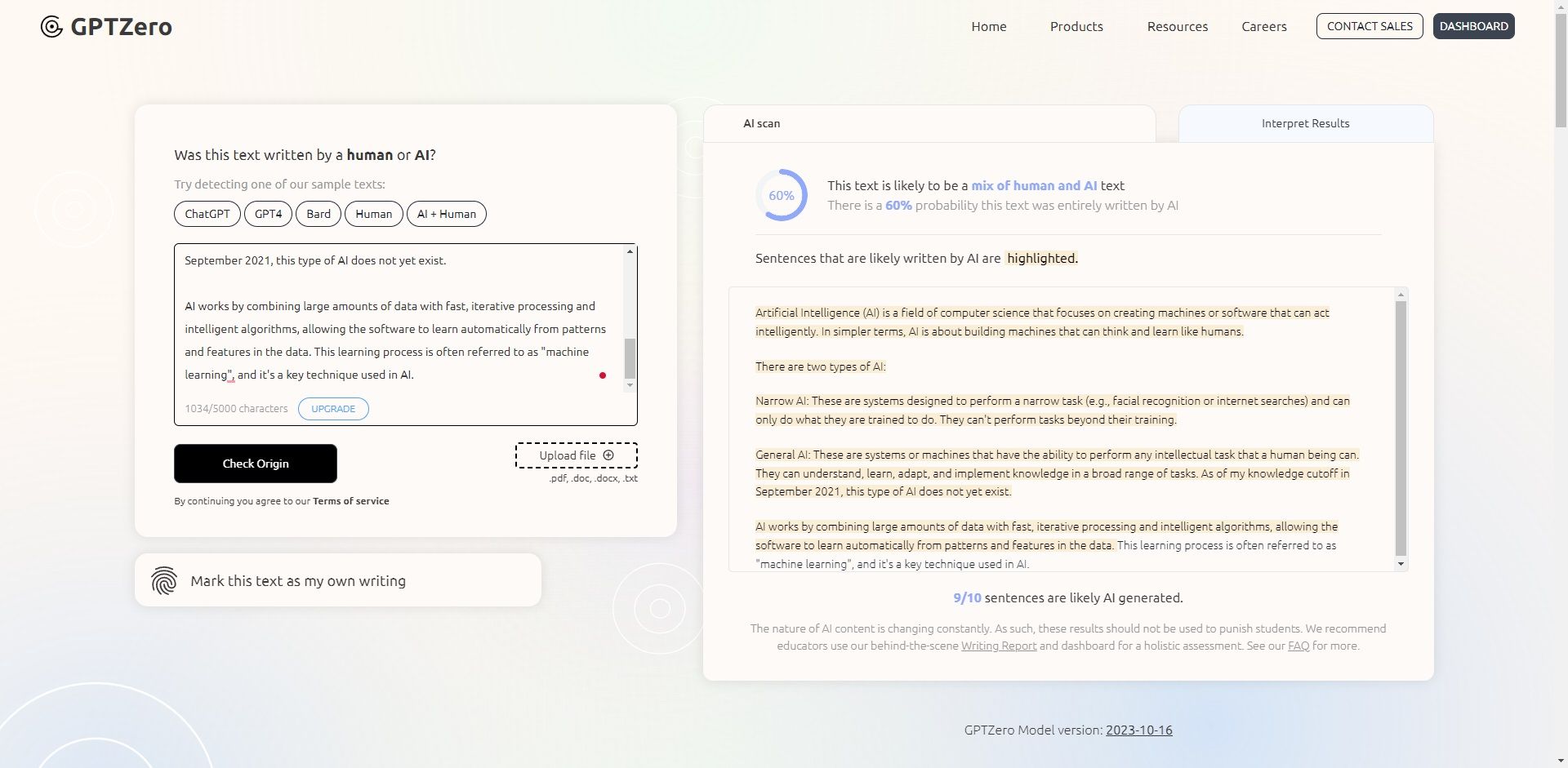
You can also use other AI writing tools to generate the text you want to analyze.
2. The Analysis of Paraphrased AI-Generated Text in GPTZero
You can choose from hundreds of paraphrasing tools to paraphrase text. In this case, we used Scribbr. If you want to use the same tool, follow the steps:
Go to Scribbr. Copy the AI-generated text we analyzed in GPTZero earlier and paste it into the tool. Click the Paraphrase button.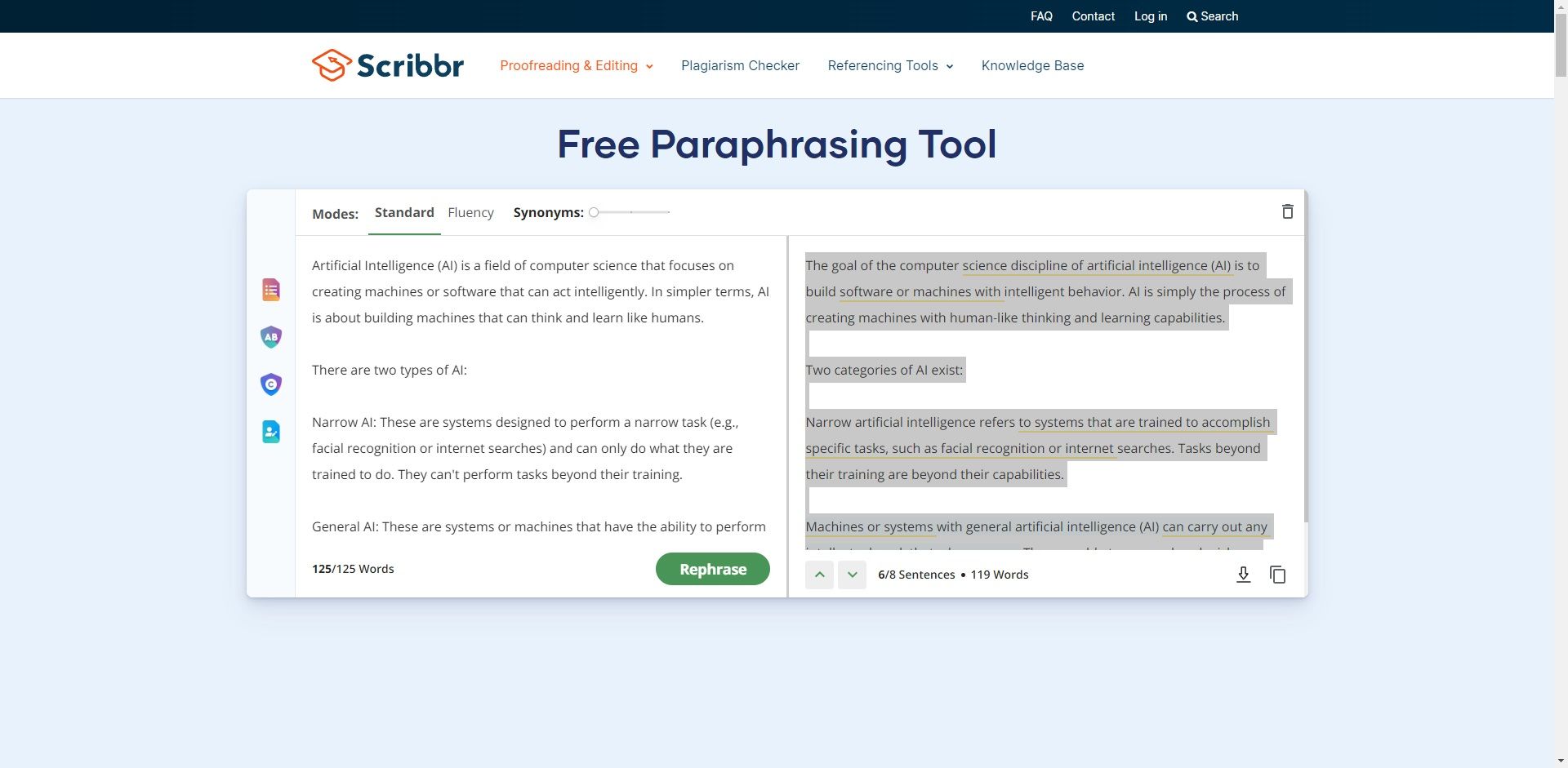 Let Scribbr paraphrase the text for you. Run the GPTZero test again after paraphrasing.
Let Scribbr paraphrase the text for you. Run the GPTZero test again after paraphrasing. We found that slight paraphrasing made it a little more difficult for GPTZero to determine whether the text was AI-generated, but it was a mixed bag overall. I'd also add that the paraphrased output was of terrible quality. The text on the left was the original, while the text on the right was the paraphrased version.

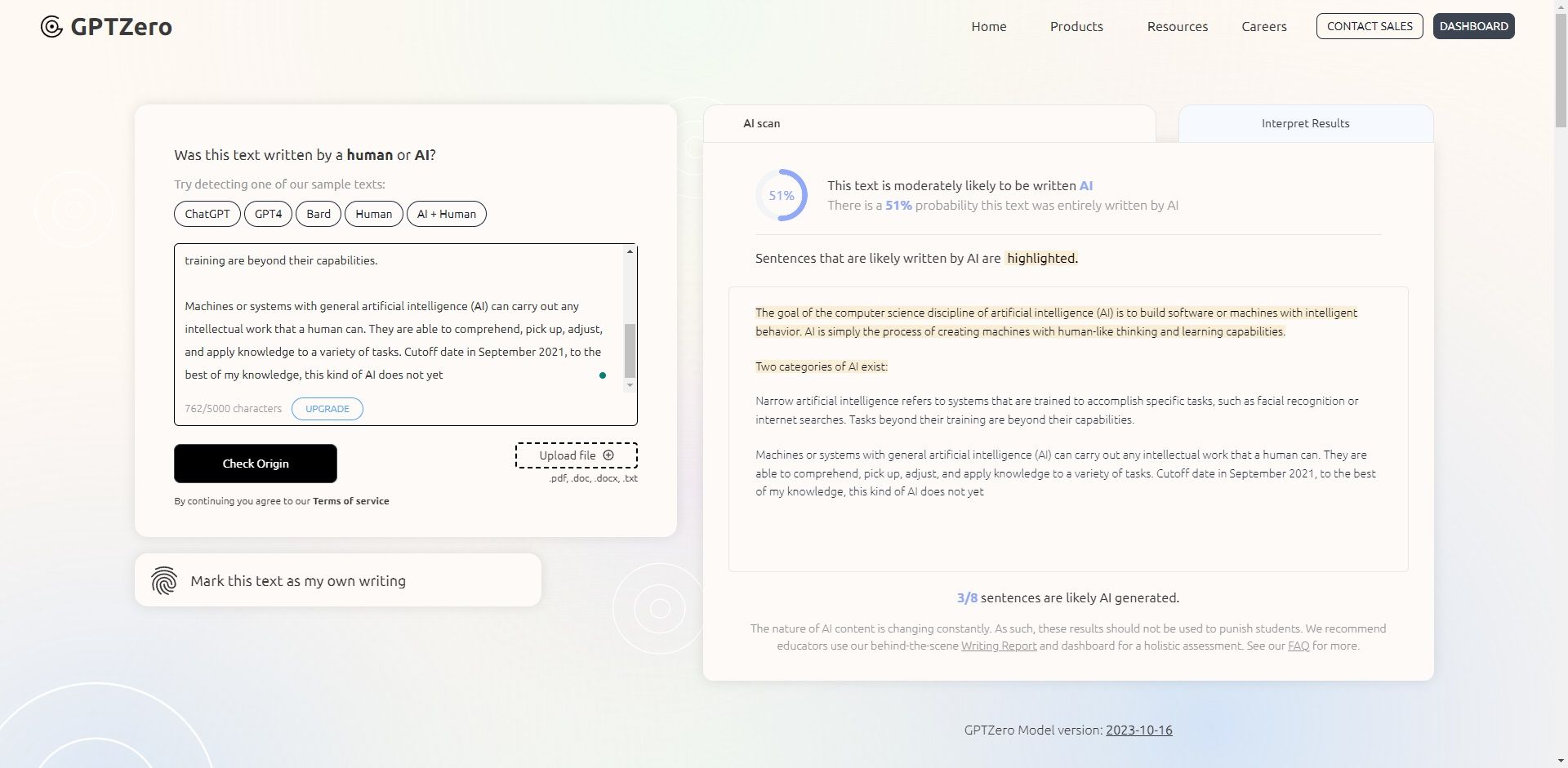
3. The Analysis of Human Written Content in GPTZero
In some cases, tools like GPTZero return a false positive result, meaning they consider something to be incorrect when it's not. To determine whether GPTZero also yields false positives, we ran several tests in the tool, analyzing different human-written pieces of text.
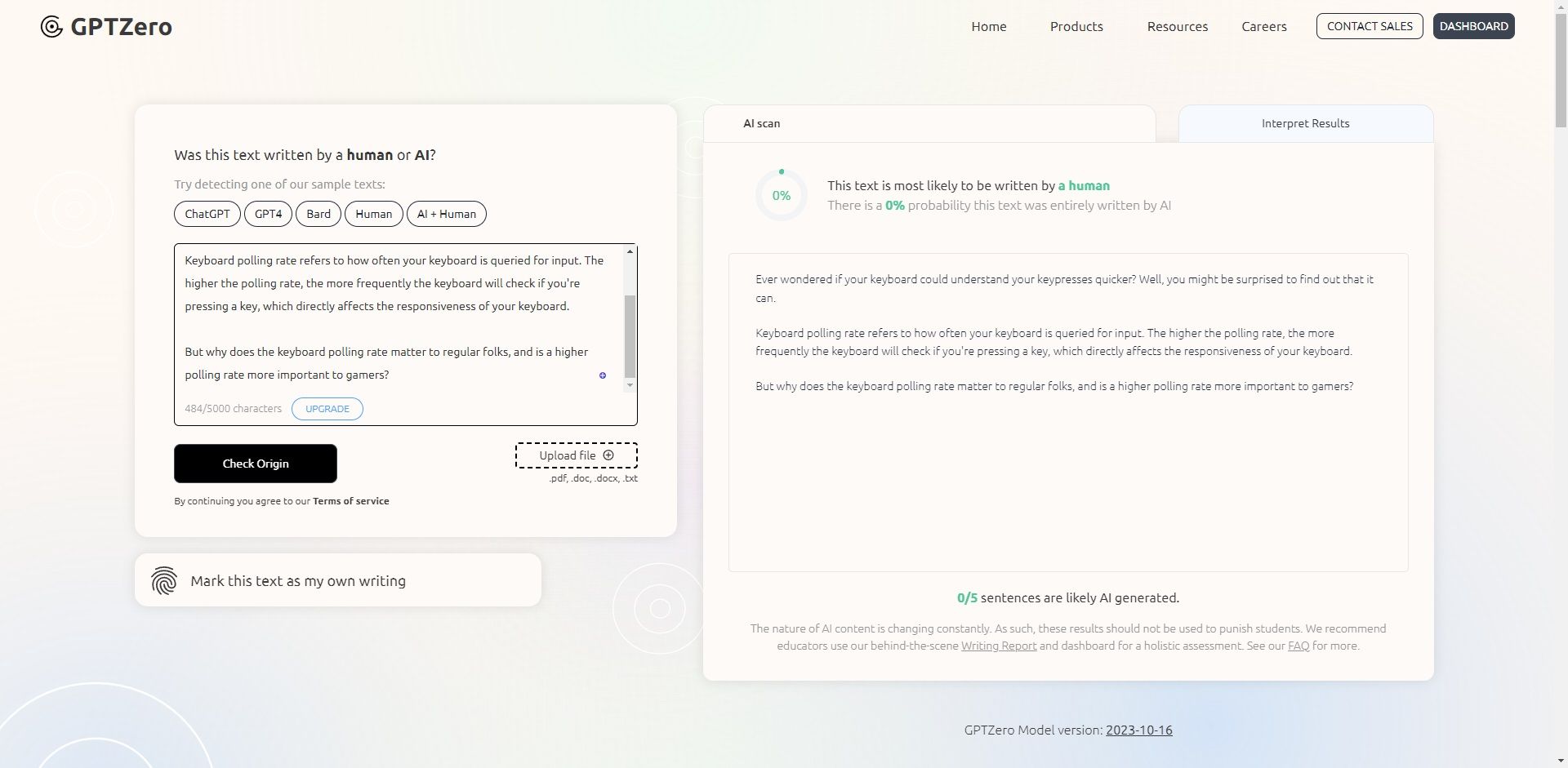

GPTZero's results were accurate for the most part despite identifying one sentence as potentially AI-written.
Should You Trust GPTZero's Results?
Based on our testing, relying solely on the results of this tool can be risky. In fact, a disclaimer appears each time you generate a result using the tool, which warns educators not to rely on this tool's results.
So, unless the tool's developer guarantees its results are foolproof, educators shouldn't fully rely on it. Why? Because it'd be unfair for a student to receive a poor grade simply because GPTZero returned a false positive.
GPTZero's Efforts to Minimize False Positives
While it still has a long way to go, GPTZero has made significant strides in reducing false positives. A new deep learning model that was deployed by the company has propelled these efforts, making the AI detection tool far more reliable than competitor services.
The new deep learning model uses a more diverse validation dataset, drawing upon sources like educational text, newspaper articles, social media posts, and Q&A content. This expanded and varied dataset allows GPTZero to distinguish between human-generated and AI-generated data better. Moreover, the company also claims that GPTZero's predictions are more "confident" than before.
Don't Always Trust AI Detection Results
As a potential antidote to OpenAI's GPT technology, GPTZero has great potential; however, it has a long way to go. At this point, it isn't entirely trustworthy. But will GPTZero's main version overcome all limitations and catch the AI content with accuracy? We'll just have to wait to find out.
-
 Try Asking ChatGPT These Fun Questions About YourselfEver wondered what ChatGPT knows about you? How it processes the information you've fed it over time? I've used ChatGPT heaps in different sce...AI Published on 2024-11-22
Try Asking ChatGPT These Fun Questions About YourselfEver wondered what ChatGPT knows about you? How it processes the information you've fed it over time? I've used ChatGPT heaps in different sce...AI Published on 2024-11-22 -
 Here\'s How You Can Still Try the Mysterious GPT-2 ChatbotIf you're into AI models or chatbots, you might have seen discussions about the mysterious GPT-2 chatbot and its effectiveness.Here, we explain wh...AI Published on 2024-11-08
Here\'s How You Can Still Try the Mysterious GPT-2 ChatbotIf you're into AI models or chatbots, you might have seen discussions about the mysterious GPT-2 chatbot and its effectiveness.Here, we explain wh...AI Published on 2024-11-08 -
 ChatGPT’s Canvas Mode Is Great: These Are 4 Ways to Use ItChatGPT's new Canvas mode has added an extra dimension to writing and editing in the world's leading generative AI tool. I've been using C...AI Published on 2024-11-08
ChatGPT’s Canvas Mode Is Great: These Are 4 Ways to Use ItChatGPT's new Canvas mode has added an extra dimension to writing and editing in the world's leading generative AI tool. I've been using C...AI Published on 2024-11-08 -
 How ChatGPT\'s Custom GPTs Could Expose Your Data and How to Keep It SafeChatGPT's custom GPT feature allows anyone to create a custom AI tool for almost anything you can think of; creative, technical, gaming, custom G...AI Published on 2024-11-08
How ChatGPT\'s Custom GPTs Could Expose Your Data and How to Keep It SafeChatGPT's custom GPT feature allows anyone to create a custom AI tool for almost anything you can think of; creative, technical, gaming, custom G...AI Published on 2024-11-08 -
 10 Ways ChatGPT Could Help You Land a Job on LinkedInWith 2,600 available characters, the About section of your LinkedIn profile is a great space to elaborate on your background, skills, passions, and f...AI Published on 2024-11-08
10 Ways ChatGPT Could Help You Land a Job on LinkedInWith 2,600 available characters, the About section of your LinkedIn profile is a great space to elaborate on your background, skills, passions, and f...AI Published on 2024-11-08 -
 Check Out These 6 Lesser-Known AI Apps That Provide Unique ExperiencesAt this point, most folks have heard of ChatGPT and Copilot, two pioneering generative AI apps that have led the AI boom.But did you know that heaps o...AI Published on 2024-11-08
Check Out These 6 Lesser-Known AI Apps That Provide Unique ExperiencesAt this point, most folks have heard of ChatGPT and Copilot, two pioneering generative AI apps that have led the AI boom.But did you know that heaps o...AI Published on 2024-11-08 -
 These 7 Signs Show We\'ve Already Reached Peak AIWherever you look online, there are sites, services, and apps proclaiming their use of AI makes it the best option. I don't know about you, but it...AI Published on 2024-11-08
These 7 Signs Show We\'ve Already Reached Peak AIWherever you look online, there are sites, services, and apps proclaiming their use of AI makes it the best option. I don't know about you, but it...AI Published on 2024-11-08 -
 4 AI-Checking ChatGPT Detector Tools for Teachers, Lecturers, and BossesAs ChatGPT advances in power, it's getting harder to tell what's written by a human and what's generated by an AI. This makes it hard for...AI Published on 2024-11-08
4 AI-Checking ChatGPT Detector Tools for Teachers, Lecturers, and BossesAs ChatGPT advances in power, it's getting harder to tell what's written by a human and what's generated by an AI. This makes it hard for...AI Published on 2024-11-08 -
 ChatGPT\'s Advanced Voice Feature Is Rolling Out to More UsersIf you have ever wanted to have a full-blown conversation with ChatGPT, now you can. That is, as long as you pay for the privilege of using ChatGPT. M...AI Published on 2024-11-08
ChatGPT\'s Advanced Voice Feature Is Rolling Out to More UsersIf you have ever wanted to have a full-blown conversation with ChatGPT, now you can. That is, as long as you pay for the privilege of using ChatGPT. M...AI Published on 2024-11-08 -
 What Is AI Slop and What Can You Do About It?You may have heard the term “AI slop” in regard to the bizarre AI-generated images circulating on social media. You may have even seen these images y...AI Published on 2024-11-08
What Is AI Slop and What Can You Do About It?You may have heard the term “AI slop” in regard to the bizarre AI-generated images circulating on social media. You may have even seen these images y...AI Published on 2024-11-08 -
 6 Reasons I Love the AI Explosion More Than the Crypto BoomThe AI explosion seems to echo the frenzy we saw during the crypto boom—everyone’s talking about it, predicting how it’ll reshape the world. But while...AI Published on 2024-11-08
6 Reasons I Love the AI Explosion More Than the Crypto BoomThe AI explosion seems to echo the frenzy we saw during the crypto boom—everyone’s talking about it, predicting how it’ll reshape the world. But while...AI Published on 2024-11-08 -
 AI Checkers Are Useless, and These 5 Examples Prove WhyWhether you're a professional writer or a student who frequently writes essays, you're probably tired of running your work through AI detector...AI Published on 2024-11-08
AI Checkers Are Useless, and These 5 Examples Prove WhyWhether you're a professional writer or a student who frequently writes essays, you're probably tired of running your work through AI detector...AI Published on 2024-11-08 -
 How I Use ChatGPT to Translate Videos and Save TimeIf you’ve ever tried translating a video into another language, you know how quickly it can turn into a time-consuming task. That’s where ChatGPT, spe...AI Published on 2024-11-08
How I Use ChatGPT to Translate Videos and Save TimeIf you’ve ever tried translating a video into another language, you know how quickly it can turn into a time-consuming task. That’s where ChatGPT, spe...AI Published on 2024-11-08 -
 6 OpenAI Sora Alternatives You Can Try for FreeRunway's Gen-2 best mirrors what you'd get using Open AI's Sora, using a multimodal AI system to generate video clips using text prompts....AI Published on 2024-11-08
6 OpenAI Sora Alternatives You Can Try for FreeRunway's Gen-2 best mirrors what you'd get using Open AI's Sora, using a multimodal AI system to generate video clips using text prompts....AI Published on 2024-11-08 -
 Why I Prefer Niche AI Chatbots Over ChatGPT ItselfMost niche AI chatbots available online are powered by ChatGPT (or OpenAI's GPT3 or GPT4). Still, I prefer these specialized chatbots over ChatGPT...AI Published on 2024-11-07
Why I Prefer Niche AI Chatbots Over ChatGPT ItselfMost niche AI chatbots available online are powered by ChatGPT (or OpenAI's GPT3 or GPT4). Still, I prefer these specialized chatbots over ChatGPT...AI Published on 2024-11-07
Study Chinese
- 1 How do you say "walk" in Chinese? 走路 Chinese pronunciation, 走路 Chinese learning
- 2 How do you say "take a plane" in Chinese? 坐飞机 Chinese pronunciation, 坐飞机 Chinese learning
- 3 How do you say "take a train" in Chinese? 坐火车 Chinese pronunciation, 坐火车 Chinese learning
- 4 How do you say "take a bus" in Chinese? 坐车 Chinese pronunciation, 坐车 Chinese learning
- 5 How to say drive in Chinese? 开车 Chinese pronunciation, 开车 Chinese learning
- 6 How do you say swimming in Chinese? 游泳 Chinese pronunciation, 游泳 Chinese learning
- 7 How do you say ride a bicycle in Chinese? 骑自行车 Chinese pronunciation, 骑自行车 Chinese learning
- 8 How do you say hello in Chinese? 你好Chinese pronunciation, 你好Chinese learning
- 9 How do you say thank you in Chinese? 谢谢Chinese pronunciation, 谢谢Chinese learning
- 10 How to say goodbye in Chinese? 再见Chinese pronunciation, 再见Chinese learning

























